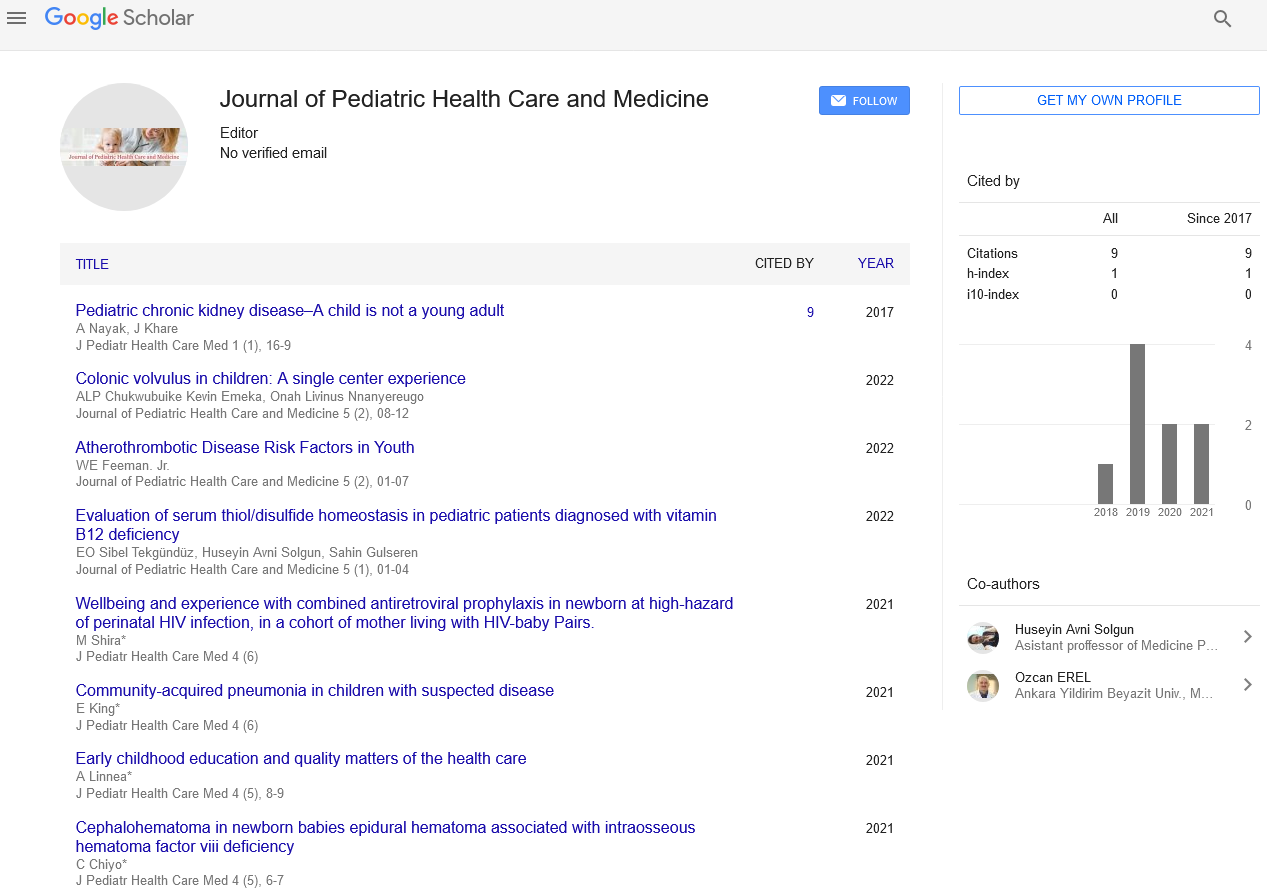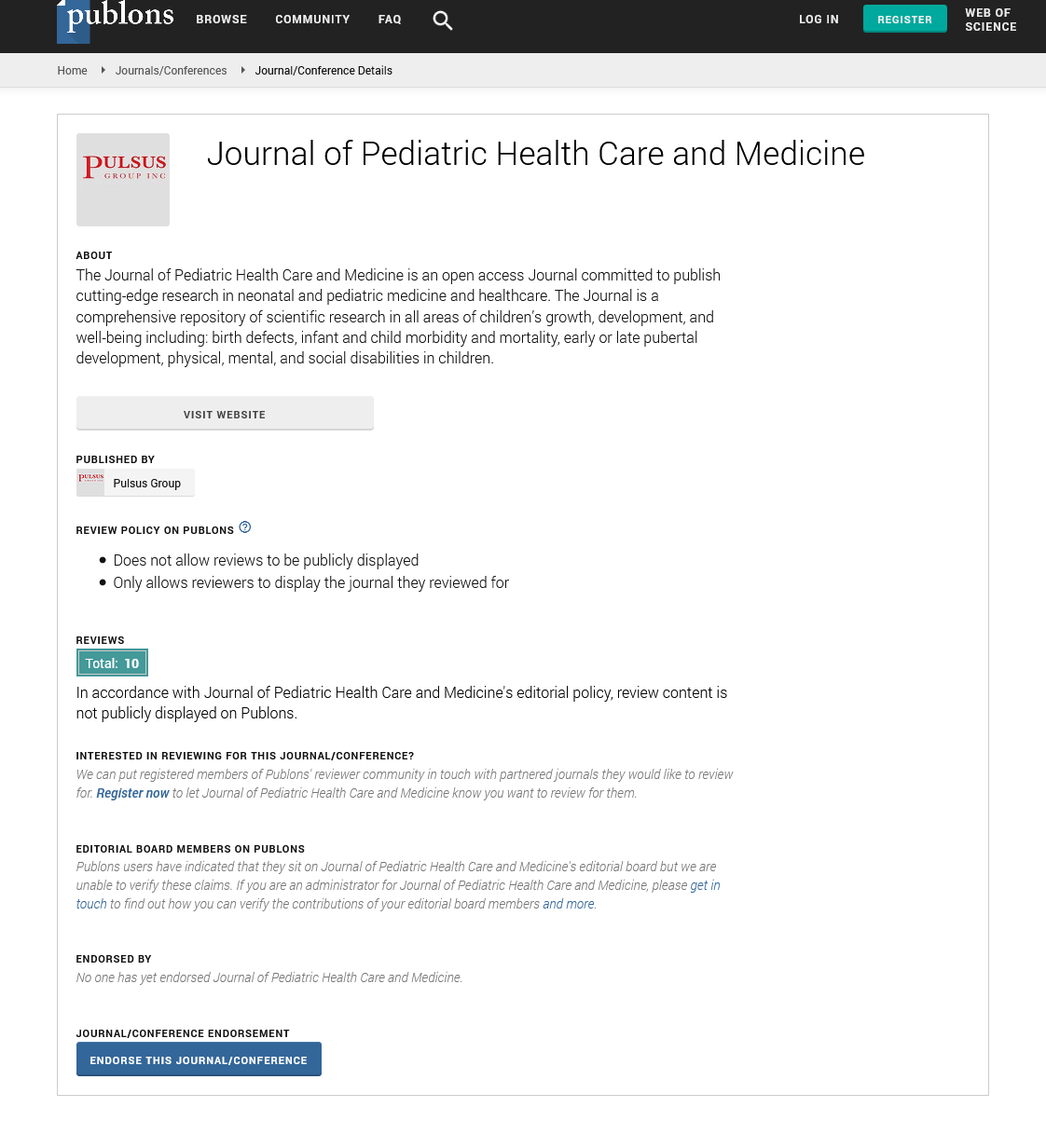Moving toward newborns at risk of hyperinsulinemic hypoglycemia
Received: 03-Oct-2022, Manuscript No. puljphcm-22-5538; Editor assigned: 08-Oct-2022, Pre QC No. puljphcm-22-5538 (PQ); Accepted Date: Oct 28, 2022; Reviewed: 23-Oct-2022 QC No. puljphcm-22-5538 (Q); Revised: 26-Oct-2022, Manuscript No. puljphcm-22-5538 (R); Published: 31-Oct-2022
Citation: Shah M. Moving toward newborns at risk of hyperinsulinemic hypoglycemia. J Pediatr Health Care Med. 2022;5(4):53-54.
This open-access article is distributed under the terms of the Creative Commons Attribution Non-Commercial License (CC BY-NC) (http://creativecommons.org/licenses/by-nc/4.0/), which permits reuse, distribution and reproduction of the article, provided that the original work is properly cited and the reuse is restricted to noncommercial purposes. For commercial reuse, contact reprints@pulsus.com
Abstract
A neonatologist assumes a basic part in the administration of children with hypoglycemia. Albeit neonatal hypoglycemia has been traditionally characterized as glucose ≤2.5 mmol/L, levels ≤2.8 mmol/L among children raise worries of neuroglycopenia, supporting the Pediatric Endocrine Societies' idea to target plasma glucose levels >2.8 mmol/L in at‑risk babies <48 h old enough and >3.3 mmol/L for those matured >48 h. The neonatologist needs to distinguish at‑risk babies and enlist them into a pathway that guarantees protected, physiological progress to extra uterine life. Physiological progress is early enteral taking care of, exploring the glucose nadir while keeping up with mother-youngster holding. Smooth umbilical to enteral progress of glucose homeostasis following birth needs satisfactory glycogen stores and suitable counter‑regulatory chemical reactions. At the point when stores are lacking and counter‑regulatory reactions fall flat, glucose guideline becomes more reliant upon suitable β‑cell reactions. Nonetheless, β‑cell dysregulation may cause improper insulin emission when hypoglycemic (hyperinsulinemic hypoglycemia [HH]) that can be transient, delayed, or relentless. The larger part contains transient and delayed types of HH that recuperate in days to weeks with takes care of or short‑term parenteral glucose mixture or seldom with the utilization of KATP channel agonist, diazoxide. The minority with persevering structures might have hereditary transformations in somewhere around 12 qualities (ABCC8, KCNJ11, GLUD1, GCK, HADH, SLC16A1, UCP2, HNF4A, HNF1A, HK1, PGM1, and PGMM2) and need clinical or potentially careful intercession, as well as long‑term multidisciplinary expert consideration. Despite the fact that there is intricacy to an administration structure that starts in the main hours to days of life, a delicate, physiological, and staged approach can prompt improved results.
Keywords
Hypoglycemia, homeostasis, C-peptide
Introduction
The Hypoglycemia stays the most well-known the metabolic issues in children. Innate hyperinsulinism (CHI), due to dysregulated insulin discharge from pancreatic βâ??cells has progressively been answered to cause obstinate hypoglycemia in newborn children. Glucose is the central neuronal energy source, and in hyperinsulinism, there is an expansion in the utilization of glucose and hindrance of glycogenolysis, gluconeogenesis, and ketogenesis, denying the mind of the two its essential (glucose) and optional energy powers (ketone bodies). Hypoglycemia is known to cause irreversible neuronal injury justifying brief acknowledgment and treatment. Information on glucose homeostasis, proper lab examinations for mediator metabolites during hypoglycemia, and brief commencement of clinical treatment is imperative in the executives of hyperinsulinemic hypoglycemia (HH) [1]. Neonatal hypoglycemia has been ordinarily characterized as glucose ≤2.5 mmol/L, and levels ≤2.8 mmol/L among children raise worries of neuroglycopenia, frequently provoking prompt clinical action. However, glucose levels of 1.4-1.7 mmol/L in well-term babies in the initial 2 h of life addresses a physiological nadir that doesn't need clinical intervention. Navigating through this basic change, period requires enteral taking care of and enthusiasm for the nadir since it is obscure how parenteral glucose during a glucose nadir would impact βâ??cell capability. Babies atâ??risk of hypoglycemia incorporate newborn children brought into the world to diabetic moms, huge for gestational age, little for gestational age, preterm, and newborn children brought into the world to overweight moms [2]. The mechanism of hypoglycemia in IDM, LGA, and IOM is connected with improper insulin levels that cause HH. In SGA and PT newborn children, explanations behind hypoglycemia are multifactorial in any case, basically connected with substrate lack. The atâ??risk babies involve roughly oneâ??third of infants what's more, may require mediation that incorporates early parenteral dextrose. As parenteral glucose applies a direct impact on the βâ??cell, while stomach peptide chemicals and firstâ??pass through the liver tweak βâ??cell reactions to enteral feeds, expecting transient isn't preposterous dysregulation of βâ??cell capability among newborn children who get early parenteral glucose. Despite the fact that there is intricacy in the hypoglycemia the executive's structure starts in the main hours to long periods of life, a more delicate, physiological, and staged the approach can prompt improved results in the administration of newborn children atâ??risk for hypoglycemia. This audit the article portrays a stepwise, functional work process on the board of these atâ??risk babies depend on the physiology of fetal and neonatal glucose homeostasis.
Insulin emission and glucose homeostasis in hatchlings and babies
Fuel for fetal digestion is created generally by the oxidation of glucose. Maternal Plasma Glucose (PG) levels keep up with constant glucose supply to the baby, uncovering the fetal mind to PG fixation as it were somewhat underneath that of maternal plasma with fetomaternal PG contrast of 0.5 mmol/L. During the umbilical to enteral change upon entering the world, in wellâ??term newborn children, the PG levels drop to a nadir of 1.4-1.7 mmol/L by 1 h old enough and afterward consistently ascend to 3-3.3 mmol/L by 2 h old enough and proceed to rise and keep up with PG in the scope of 3.9-5.9 mmol/L. Transitional hypoglycemia in babies is supposed to determine within 48 h of life. In the prompt neonatal period, hepatic glycogenolysis gives glucose, though βâ??oxidation of unsaturated fats and lactate age because of proteolysis give substrate to gluconeogenesis [3].
Hyperinsulinemic hypoglycemia determination
A finding of HH is made when serum insulin C-peptide is distinguishable within the sight of hypoglycemia in newborn children >48 h of life getting a glucose imbuement rate (GIR) of >8 mg/kg/min simultaneously with hypoketonemia, hypofattyacidemia, and a positive glycemic reaction to glucagon, HH in newborn children can be transient, delayed, or industrious (inborn). Transient HH might be noticed in IDM, IOM, SGA, LGA, newborn children with perinatal asphyxia, or Rh isoimmunization, and, surprisingly, in those without risk factors. Although no unmistakable definition is given how long transient hypoglycemia would last, the goal happens inside the space of days following augmentation of takes care of or shortâ??term glucose imbuement. Delayed HH may be seen in SGA babies who require high GIR and exhibit diazoxide responsiveness where goal is seen in weeks to months. Tireless HH, seen in CHI, may have more serious aggregates with changes in somewhere around 12 qualities (ABCC8, KCNJ11, GLUD1, GCK, HADH, SLC16A1, UCP2, HNF4A, HNF1A, HK1, PGM1, and PMM2) that adjust βâ??cell capability have been accounted for. Likewise, hereditary changes have moreover been accounted for which cause syndromic illnesses with HH. Histologically, hereditary types of HH can be central, diffuse, or atypical [4].
Care for newborn children in danger for hypoglycemia
Newborn children at risk of hypoglycemia ought to be observed for hypoglycemia from birth. Asymptomatic highâ??risk youngsters ought to be given a feed (bosom or equation milk) during the period of glucose nadir at 1 h of life, what's more, glucose levels checked at 2 h of age. Parental history of affiliation, family background of earlyâ??onset diabetes, and kin with a background marked by seizures/unexpected breakdown (characteristic blunder of digestion) may highlight an acquired cause for hypoglycemia. History of maternal diabetes, corpulence, perinatal asphyxia, gestational age, also, birth weight (SGA/LGA) could show the etiology of hypoglycemia. Physical assessment might uncover conditions related to HH.
The administration of babies atâ??risk of hypoglycemia, which starts in the primary hours too long stretches of existence with the potential to prompt a conclusion of HH is of major interest to specialists taking care of infants. In spite of the fact that there is intricacy in the general system of care, the basic designated spots in the pathway are upstream also, incorporate perceiving and exploring the glucose nadir, picking the proper type of treatment during hypoglycemia, and guaranteeing an exact conclusion of HH [5]. The center of the cycle includes the evaluation of Diazoxide responsiveness, which becomes the dominant focal point and decides treatment and visualization. Further downstream, the well-being and goal of fasting concentrates on playing significant jobs in the progress from emergency clinic to home consideration.
References
- Cox DJ, Gonder-Frederick L, Antoun B, et al. Perceived symptoms in the recognition of hypoglycemia. Diabetes care. 1993;16(2):519-27.
- Goldberg IJ, Brown LK, Rayfield EJ. Disopyramide (Norpace®)-induced hypoglycemia. Am J Med. 1980;69(3):463-6.
- Brun JF, Fédou C, Mercier J. Postprandial reactive hypoglycemia. Diabetes metab. 2000;26(5):337-52.
[Google scholar] [Cross Ref]
- Gold AE, MacLeod KM, Frier BM, et al. Changes in mood during acute hypoglycemia in healthy participants. J pers soc psychol. 1995;68(3):498-504.
- Shorr RI, Ray WA, Daugherty JR, et al. Antihypertensives and the risk of serious hypoglycemia in older persons using insulin or sulfonylureas. JAMA. 1997;278(1):40-3.






